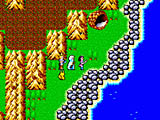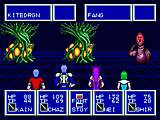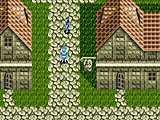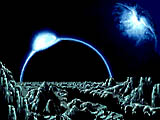
| Platform: Game Boy Advance | Publisher: THQ |
| Previewer: John McCarroll | Developer: SEGA/Digital Eclipse |
| Preview Update: none | Expected Release: Fall 2002 |
|
Preview 8/20/02 Not much happened in 1987. Baby Jessica fell down a well and Ronald Reagan spoke at the Berlin wall. In the eyes of many a gamer, 1987 was the beginning of an era with Segaís release of Phantasy Star for the Master System. Sega followed up with three sequels on the Genesis; considered by many to be the greatest RPGs ever released. Recently, many 16-bit RPGs have been re-released for the Game Boy Advance and Sega is jumping on the bandwagon. Surprisingly, Sega has handed the torch to THQ to publish these games for the GBA. Much to the chagrin of Phantasy Star fans, THQ has deemed 128-bit cartridges too expensive and Phantasy Star IV: The End of the Millenium has been cut from the collection.
Digital Eclipse, the company THQ has hired to do the conversion, is leaving the games relatively untouched, save for a retranslation. The graphics will be exactly the same as the original releases. Gamers eagerly awaiting the chance to play these legendary games may find themselves aesthetically disappointed. Phantasy Starís once revolutionary, sprite-based three-dimensional dungeons now appear mundane. Phantasy Star II and III spiced things up with 16-bit graphics and an overhead dungeon perspective, but remain painfully dated. The dungeon design for the series remains excellent, save for the third game and they suffice.
The Phantasy Star series is based in the Algo star system, a triumvirate of planets which include the desert planet Motavia, the lush Palma, and the frozen wasteland of Dezolis. The series is an ongoing legacy of brave attempts to halt the continuous resurrection of a great evil every one thousand years. Phantasy Star is the adventure of Alis, a young woman whose brother was slain by the evil King Lassic. In her quest for justice, she will meet and travel with the hunter Odin and the mysterious creature known as Myau. Alis, as well as most of the main characters from the series, will visit all three planets in the star system before the true evil is revealed and eventually confronted.
Phantasy Star II follows the path of Rolf, a government agent sent to the Bio-Systems lab to discover the source of recent monster attacks. Accompanying Rolf is Nei, a hybrid human/bio-monster who mysteriously appeared at his home several months prior to these disturbing events. Their simple investigation will lead them across two planets and witness the death of millions before the story completely unfolds. The third game, Phantasy Star III: Generations of Doom is the story of a family across three generations, eventually following eight different heroes. The tale begins with Rhys, a prince whose bride is kidnapped from the altar, and his quest to rescue his beloved. His journey will lead him to cross paths with an evil which ultimately extends into the next two generations of his family. Each generationís characters and storyline are based on the wife chosen by the hero of the previous generation, resulting in seven children across six possible generations of play (one generation features twins).
The music of the Phantasy Star Collection may be easily forgettable in an era of CD audio, but the PCM tunes of the series are bound to evoke fond memories in older gamers. Due to the age of these games, the acoustics may not be state of the art, but they should contend with even the best GBA RPG.
The Phantasy Star series is from the old school, utilizing an incredibly standard turn-based combat system. Combat is viewed from a 1st person perspective in parts one and three, while Phantasy Star II uses a 3rd person perspective. While The End of the Millenium utilized an ability combo system, the first three incarnations of the series were never innovative. In combat, the animations appear well done, if uninspired, with the third game being notoriously average. Characters will gain spells and abilities based on their class as well as their experience.
The Phantasy Star series has been a longtime favorite of RPG fans the world over. Despite being ancient, the saga has always been more than just the sum of its parts. Though the omission of Phantasy Star IV, arguably the best chapter in the series, will have fanboys crying, Phantasy Star Collection oozes a certain kind of retro-style that will certainly be welcomed by gamers of all ages. Phantasy Star Collection is slated for a Fall 2002 release by THQ. |
|




